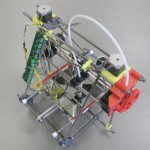 From Tech Today:
From Tech Today:
Chelsea Schelly (SocSci), Gerald Anzalone (MSE), Bas Wijnen (MSE), Joshua M. Pearce (MSE/ECE) published a paper on “Open-source 3-D printing technologies for education: Bringing additive manufacturing to the classroom” in the Journal of Visual Language and Computing.
ABSTRACT:
Objective
3-D printing technologies have the potential to improve both Science, Technology, Engineering, and Mathematics (STEM) education and Career and Technical Education (CTE), as well as integrating these two educational emphases and providing opportunities for cross-curriculum engagement. The objective of this study is to investigate the potential of open-source (OS) technologies in an educational setting, given the combination of economic constraints affecting all educational environments and the ability of OS design to profoundly decrease the cost of technological tools and technological innovation.
Methods
This paper reports on a 3-day workshop augmented with online instructional and visual tools designed for middle school and high school level educators from a wide array of disciplines (including traditional science, math, and engineering as well as computer, shop, and art). Teachers (n=22) submitted applications to participate in the workshop, the workshop was observed for both evaluation and research, teachers participated in focus groups (n=2) during the workshop in order to discuss their interest in OS 3-D printing technology and its potential role in their classrooms, and teachers completed a voluntary post-workshop survey and responded to follow-up after printers were in the classroom for one year.
Results
During the workshop teachers built 3-D printers using OS technologies that they were then able to take back to their schools and into their classrooms.
Conclusion
Through workshops augmented with online instructional and visual tools designed to provide facilitated yet self-directed engagement with a new, relatively unknown, and relatively complex technology, paired teacher teams were able to successfully build and use RepRap 3-D printers based on OS design in just three days.
Practice
Here, we discuss both what the teachers learned and what we learned from the teachers regarding the potential for educators to construct OS 3-D printing technologies as a tool of empowering and transformative education.
Implications
Open-source 3-D printing technologies have the potential to improve education through a sense of empowerment resulting from active participation, as well as through cross-curriculum engagement.